Assessing Green Development Efficiency of Municipalities and Provinces in China Integrating Models of Super-Efficiency DEA and Malmquist Index
Abstract
:1. Introduction
“Urban green growth means fostering economic growth and development through urban activities that reduce negative environmental externalities, the impact on natural resources and the pressure on ecosystem services. The greening of the traditional urban economy and expanding the green urban sector can generate growth (through increased supply and demand), job creation and increased urban attractiveness. These effects are in part the result of stronger interactions at the urban level among economic efficiency, equity and environmental objectives.”From: Cities and Green Growth: A Conceptual Framework
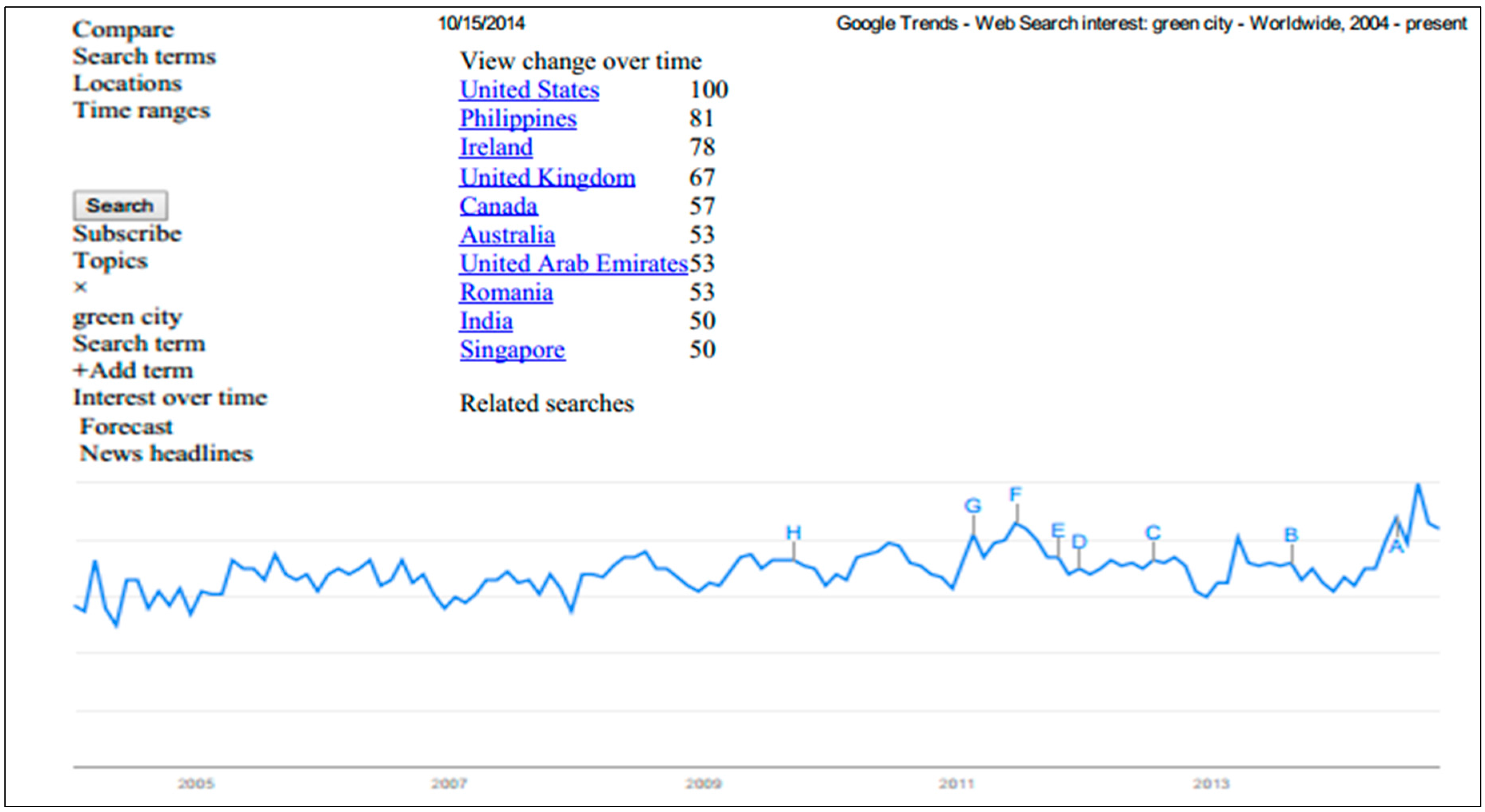
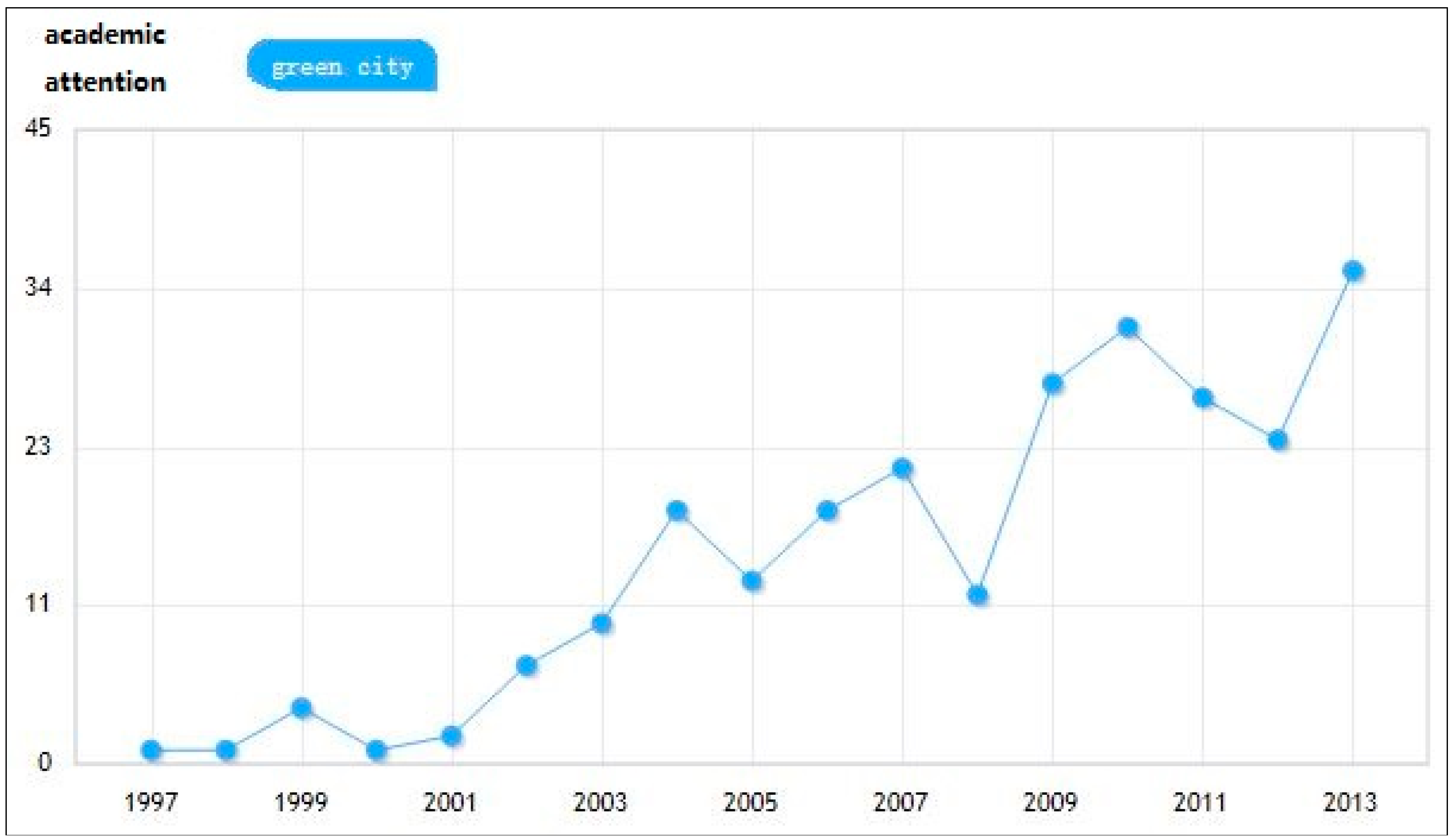
2. Methods
2.1. CCR-DEA Model
2.2. Sup-CCR-DE
A Model
2.3. Malmquist Index Approach
- Effchk represents the relative efficiency index of region K;
- Techk represents the regional green technology development efficiency of K;
- Peckk represents the pure development efficiency of region K;
- Sechk represents the scale development efficiency of region K.
3. Indicator Systems
| Names of Indicator | Mean Value | Standard Deviation | Coefficient of Variation |
|---|---|---|---|
| Gross Regional Product (100 million Yuan) | 18,598.5 | 14,326.0 | 0.8 |
| Share of the Tertiary Industry to the GDP | 41.3 | 9.2 | 0.2 |
| Urban Residential Investment (100 million Yuan) | 1864.2 | 1244.9 | 0.7 |
| Household Consumption Expenditure (100 million Yuan) | 6247.9 | 4918.4 | 0.8 |
| Government Consumption Expenditure (100 million Yuan) | 2443.0 | 1700.4 | 0.7 |
| Savings Deposit of Urban and Rural Households at Year-end (100 million Yuan) | 12,846.7 | 9895.0 | 0.8 |
| Revenue of State-owned Resources Compensable Use (100 million Yuan) | 88.4 | 73.2 | 0.8 |
| Fiscal Expenditure of Energy Conservation and Environmental Protection (100 million Yuan) | 93.5 | 47.5 | 0.5 |
| Consumer Price Index | 102.7 | 0.4 | 0.0 |
| GDP Energy Consumption (tons of standard coal/ten thousand Yuan) | 1.0 | 0.5 | 0.4 |
| Resource Tax Revenue (100 million Yuan) | 27.6 | 28.8 | 1.0 |
| Green Areas in City (ectare) | 76,382.0 | 78,578.3 | 1.0 |
| Total Number of Special Vehicles and Equipments for City Appearance and Environmental Sanitation | 3618.0 | 2564.7 | 0.7 |
| Daily Treatment Capacity of Urban Sewage (10 thousand cubic metre) | 441.7 | 395.6 | 0.9 |
| MSW delivering quantity (10 thousand ton) | 551.0 | 422.2 | 0.8 |
| Innocuous Disposal of Domestic Garbage | 84.8 | 15.5 | 0.2 |
| Registered Urban Unemployment Rate | 3.3 | 0.6 | 0.2 |
| Per Capita Annual Cash Living Expenditure of Urban Households by Income Percentile (yuan) | 23,218.6 | 5844.4 | 0.3 |
| Green Coverage Rate of Build-up Area | 38.5 | 3.8 | 0.1 |
| Water Penetration in City | 96.0 | 4.8 | 0.1 |
| Gas Penetration in City | 89.3 | 14.1 | 0.2 |
| Average Wage of Employed Persons in Water Conservancy, Environment and Administration of Public Facilities (Yuan) | 24,230.4 | 6365.9 | 0.3 |
| Per Capita Water Consumption (cubic meters/per capita) | 535.7 | 457.0 | 0.9 |
| Per Capita Urban Park Green Area (square meters) | 11.8 | 2.5 | 0.2 |
| Dust Emissions (10 thousand ton) | 39.9 | 29.8 | 0.7 |
| Total Industrial Wastewater Discharges (ton) | 71,479.3 | 60,903.1 | 0.9 |
| General Industrial Solid Wastes (10 thousand ton) | 10,614.3 | 9824.5 | 0.9 |
| Forest Coverage (%) | 30.0 | 17.6 | 0.6 |
| Power Consumption (100 million Kwh) | 1599.7 | 1172.1 | 0.7 |
| Share of the Nature Reserve to the Jurisdiction % | 9.5 | 7.3 | 0.8 |
| Per Capita Water Resource (cubic metres/per capita) | 6711.8 | 24,421.0 | 3.6 |
| Industrial Waste Gas Discharge (100 million cubic metres/per capita) | 20,500.6 | 14,979.1 | 0.7 |
4. Calculation of Regional Green Development Efficiency in China
| Region | 2008 | 2009 | 2010 | 2011 | 2012 | |||||
|---|---|---|---|---|---|---|---|---|---|---|
| SUP | R | SUP | R | SUP | R | SUP | R | SUP | R | |
| Beijing | 5.34 | 3 | 5.21 | 2 | 5.02 | 3 | 5.84 | 1 | 5.67 | 1 |
| Tianjin | 0.81 | 21 | 0.83 | 19 | 0.82 | 19 | 0.82 | 17 | 0.87 | 16 |
| Hebei | 0.71 | 25 | 0.72 | 24 | 0.75 | 22 | 0.74 | 23 | 0.68 | 25 |
| Shanxi | 0.77 | 23 | 0.69 | 26 | 0.57 | 26 | 0.58 | 26 | 0.50 | 26 |
| Inner Mongolia | 0.43 | 28 | 0.46 | 28 | 0.44 | 28 | 0.39 | 28 | 0.38 | 27 |
| Liaoning | 0.99 | 15 | 1.10 | 11 | 0.89 | 15 | 0.98 | 12 | 1.12 | 9 |
| Jilin | 1.19 | 8 | 0.92 | 17 | 0.89 | 14 | 0.88 | 15 | 0.95 | 13 |
| Heilongjiang | 0.79 | 22 | 0.78 | 22 | 0.83 | 18 | 0.83 | 16 | 0.86 | 17 |
| Shanghai | 0.87 | 17 | 0.97 | 16 | 0.97 | 13 | 1.07 | 10 | 1.11 | 10 |
| Jiangsu | 1.14 | 10 | 1.13 | 9 | 1.16 | 7 | 1.21 | 6 | 1.16 | 7 |
| Zhejiang | 1.20 | 7 | 1.22 | 6 | 1.19 | 6 | 1.19 | 7 | 1.20 | 6 |
| Anhui | 0.94 | 16 | 1.05 | 12 | 0.86 | 16 | 0.76 | 21 | 0.83 | 18 |
| Fujian | 1.21 | 6 | 1.14 | 8 | 1.13 | 8 | 1.13 | 8 | 1.11 | 11 |
| Jiangxi | 1.07 | 11 | 1.02 | 13 | 1.02 | 10 | 1.08 | 9 | 1.07 | 12 |
| Shandong | 1.76 | 5 | 1.82 | 5 | 1.74 | 5 | 1.78 | 5 | 1.84 | 5 |
| Henan | 0.81 | 20 | 0.83 | 20 | 0.83 | 17 | 0.76 | 22 | 0.73 | 22 |
| Hubei | 0.67 | 26 | 0.69 | 25 | 0.69 | 25 | 0.68 | 25 | 0.72 | 23 |
| Hunan | 0.82 | 19 | 0.79 | 21 | 0.79 | 20 | 0.77 | 20 | 0.81 | 19 |
| Guangdong | 3.03 | 4 | 2.83 | 4 | 2.82 | 4 | 2.67 | 4 | 2.57 | 4 |
| Guangxi | 0.71 | 24 | 0.77 | 23 | 0.75 | 24 | 0.79 | 19 | 0.78 | 20 |
| Hainan | 5.96 | 2 | 5.00 | 3 | 5.45 | 2 | 4.95 | 2 | 4.42 | 3 |
| Chongqing | 1.00 | 14 | 1.16 | 7 | 0.98 | 11 | 0.95 | 13 | 1.15 | 8 |
| Sichuan | 1.00 | 13 | 0.99 | 14 | 0.76 | 21 | 0.79 | 18 | 0.78 | 20 |
| Guizhou | 0.87 | 18 | 0.83 | 18 | 0.75 | 23 | 0.73 | 24 | 0.69 | 24 |
| Yunnan | 1.05 | 12 | 0.98 | 15 | 0.98 | 12 | 0.94 | 14 | 0.89 | 15 |
| Tibet | 25.23 | 1 | 22.0 | 1 | 20.1 | 1 | 4.33 | 3 | 4.88 | 2 |
| Shaanxi | 1.15 | 9 | 1.11 | 10 | 1.04 | 9 | 1.00 | 11 | 0.93 | 14 |
| Gansu | 0.37 | 29 | 0.29 | 29 | 0.29 | 29 | 0.27 | 29 | 0.29 | 29 |
| Qinghai | 0.20 | 30 | 0.20 | 30 | 0.17 | 31 | 0.18 | 30 | 0.18 | 30 |
| Ningxia | 0.18 | 31 | 0.19 | 31 | 0.19 | 30 | 0.17 | 31 | 0.18 | 31 |
| Xinjiang | 0.56 | 27 | 0.49 | 27 | 0.49 | 27 | 0.43 | 27 | 0.37 | 28 |
| Region | Year | |||
|---|---|---|---|---|
| 2008–2009 | 2009–2010 | 2009–2010 | 2009–2010 | |
| Beijing | 1.186 | 1.305 | 1.108 | 1.243 |
| Tianjin | 1.050 | 1.048 | 1.139 | 1.097 |
| Hebei | 1.236 | 1.352 | 1.224 | 1.012 |
| Shanxi | 1.142 | 1.031 | 1.147 | 1.026 |
| Inner Mongolia | 1.079 | 1.005 | 1.015 | 1.022 |
| Liaoning | 1.149 | 1.256 | 1.326 | 1.136 |
| Jilin | 1.045 | 1.042 | 1.098 | 1.102 |
| Heilongjiang | 1.019 | 1.106 | 1.108 | 1.043 |
| Shanghai | 1.256 | 1.018 | 1.057 | 1.054 |
| Jiangsu | 1.017 | 1.228 | 1.408 | 1.076 |
| Zhejiang | 1.133 | 1.126 | 1.139 | 1.104 |
| Anhui | 1.075 | 1.222 | 1.131 | 1.009 |
| Fujian | 1.032 | 1.032 | 1.146 | 1.006 |
| Jiangxi | 1.065 | 1.031 | 1.136 | 1.008 |
| Shandong | 1.112 | 1.169 | 1.123 | 1.120 |
| Henan | 1.131 | 1.222 | 1.023 | 1.043 |
| Hubei | 1.068 | 1.051 | 1.161 | 1.091 |
| Hunan | 1.032 | 1.050 | 1.118 | 1.075 |
| Guangdong | 1.094 | 1.072 | 1.069 | 1.066 |
| Guangxi | 1.210 | 1.043 | 1.192 | 1.004 |
| Hainan | 1.224 | 1.207 | 0.815 | 1.068 |
| Chongqing | 1.143 | 1.179 | 1.105 | 1.124 |
| Sichuan | 1.125 | 1.049 | 1.163 | 1.017 |
| Guizhou | 1.307 | 0.910 | 0.956 | 0.960 |
| Yunnan | 1.177 | 0.990 | 0.936 | 0.955 |
| Tibet | 0.697 | 0.981 | 0.365 | 1.112 |
| Shaanxi | 1.185 | 1.050 | 0.973 | 0.952 |
| Gansu | 0.810 | 1.110 | 1.057 | 1.067 |
| Qinghai | 0.991 | 0.905 | 1.212 | 0.962 |
| Ningxia | 1.076 | 1.086 | 0.911 | 1.080 |
| Xinjiang | 0.902 | 1.038 | 0.952 | 0.875 |
| Mean Value | 1.081 | 1.089 | 0.874 | 1.046 |
5. Results and Discussion
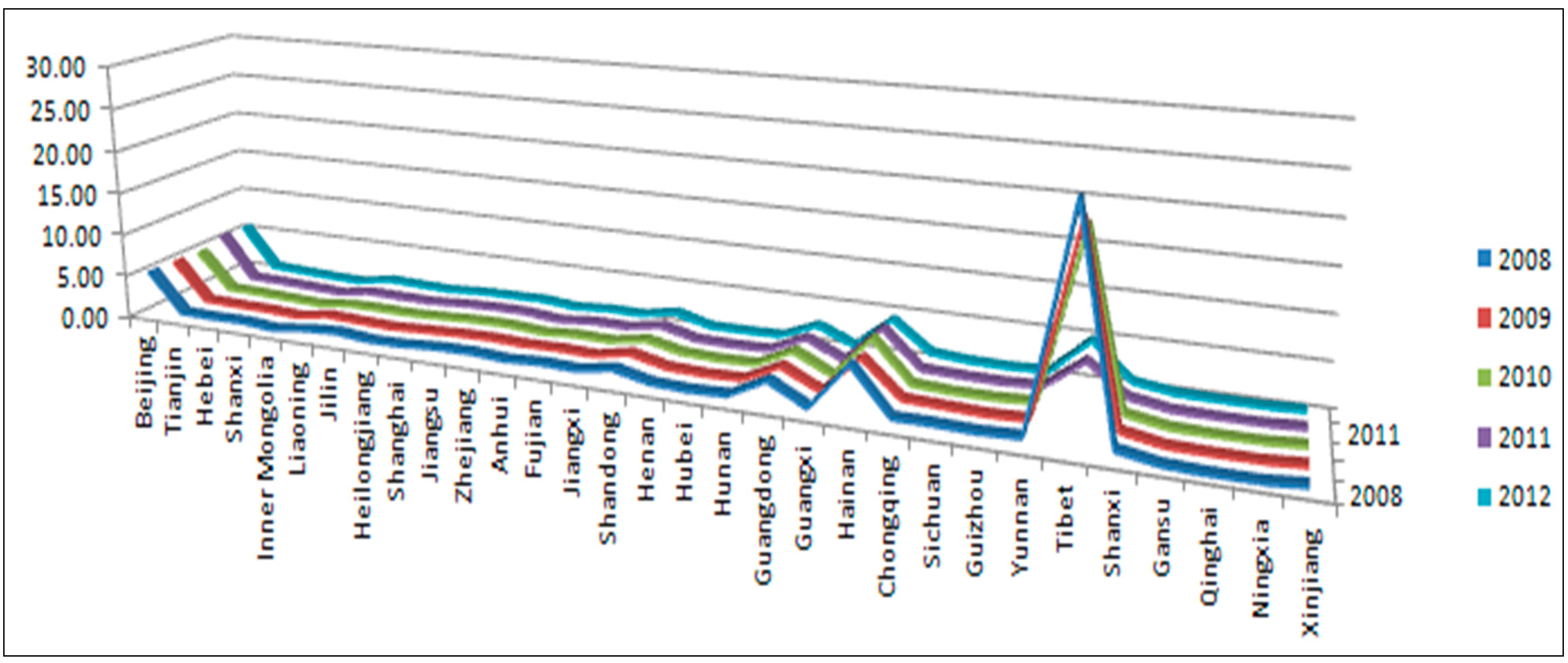
5.1. Coastal Region
- (l)
- According to the relative theory of relationship between environmental quality and per capita income studied by Grossman et al. and the relative conclusion of Kuznets curve on environment [39], it is difficult to achieve regional economic development in primary stages without sacrificing environmental quality and losing resources. As one of the fastest developing countries, China is still undergoing a difficult transition where most regions are still on the left-hand side of the inflection point on the inverted U curve, and it is inevitable that there will be stage where environmental measures are taken only after polluting the environment, as was the experience for Western developed countries. Neither the capitalistic empire Britain that has a long history just like our country, nor the world giant America that has a relatively short history, advocated environment protection in the history of its development as it has today. As the pioneer of the first industrial revolution, Britain, without rich resources, made coal its main energy source in the middle of the 18th century. Water and air pollution became increasingly serious with the rapid development of new industry. Engels’ British Working Class vividly recorded how the smog disaster and water pollution became a nightmare for residents. Similarly, on the road to becoming the world’s only superpower, the United States also paid terrible environmental costs. In November 1971, the “American file” that was announced by the newly established Environmental Protection Agency (EPA) published more than 80,000 photos by 100 American photographers, recording changes in America over the years: the oil tank of Exxon in Louisiana piled up into a mountain and Clark Street under industrial waste gas. According to the Xinhua report, the biologists Lamon Jadans, who studies air pollution and co-authored the global toxic chemicals monitoring plan of United Nations Environment Programme (UNEP), said: “several kinds of pollutants’ concentration in the air of some places in China undoubtedly reach the level of some highly industrialized regions in Europe and North America in the 1970s. But when spreading equally to economic output and individuals, those pollutants emissions is much higher than China’s current capacity, On the whole, the situation is the same now.”
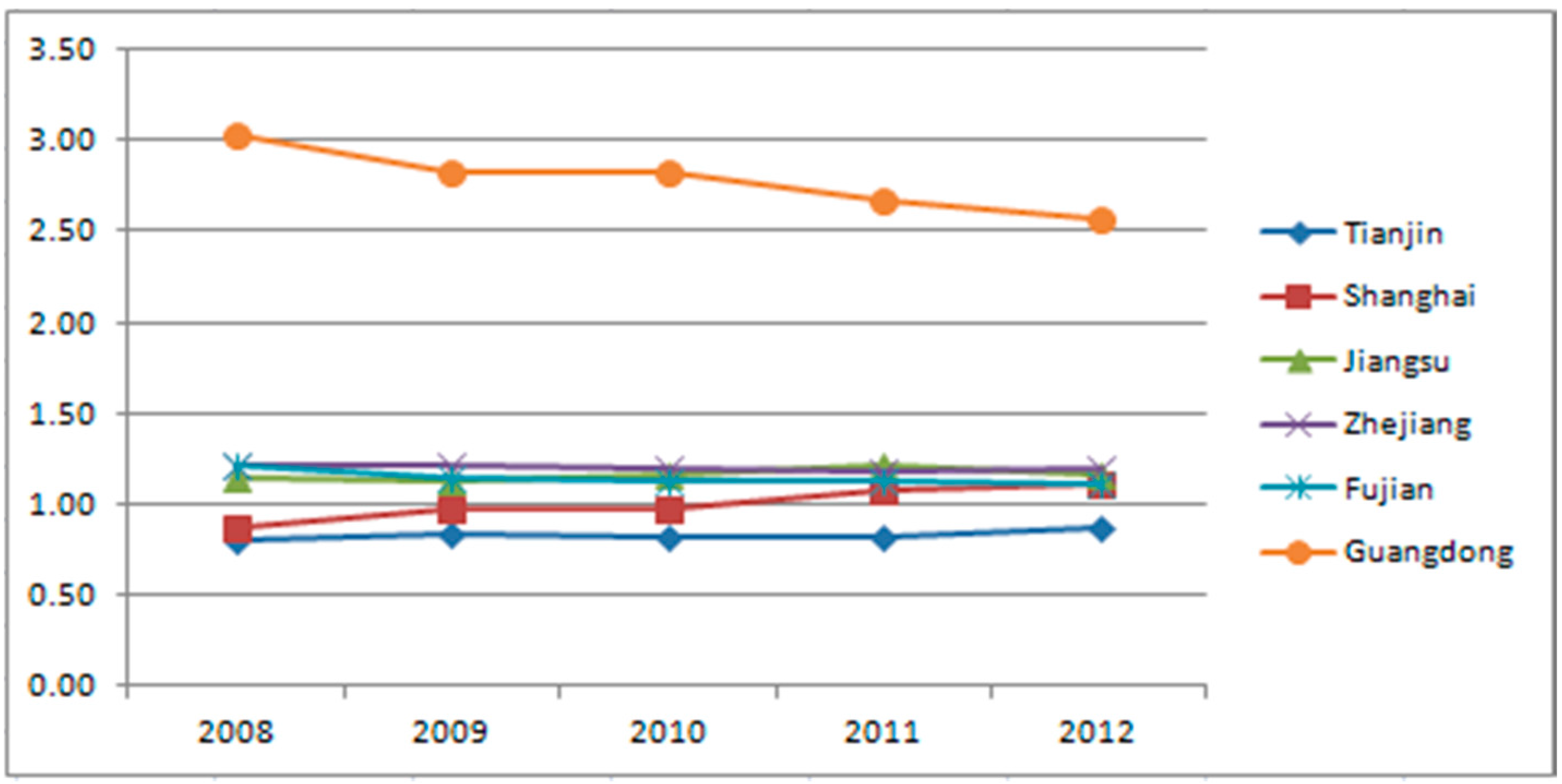
- (2)
- The urban and rural residents have a deep-rooted concept of putting their own economic interests first and they extremely lack consciousness of public environment protection. After the reform and opening up, China's coastal areas experienced rapid economic development, and the urbanization phenomenon gradually turned white-hot. According to the list of richest 10 county-level cities in China published by Forbes 2013, Jiangsu and Zhejiang earned all the places. In the eastern coastal areas, the money-oriented notion of economic status as determined by “superstructure” is deeply rooted in the people’s hearts, which seems to have become the consensus of people in the other parts of the mainland such as Jiangsu, Fujian, Guangdong and other developed areas. The road of green development is a long-term development plan. As investing in green equipment and environmental technology innovation will only increase the cost of enterprise in the short term, and the need to hire professionals and research personnel, the green road is often ignored by enterprise, institutions and individuals who pursue maximum profit in chasing immediate interests.
5.2. Six Provinces in the Central Part of China
- (1)
- The use of resources is inefficient, especially in Shanxi Province. As it is known for its rich mineral resources, Shanxi has mined a lot of coal resources in recent years to achieve prosperity, and illegal coal mines have been found everywhere. In recent years, it is common to see news likes “coal mine owner in Shanxi spent one hundred million marrying daughter”, shocking people. However, according to the indicator of economic development in Shanxi, the situation was different, which reflects there is a big gap between the rich and the poor and the development mode mainly depends on mining and consuming its regional resources.
- (2)
- Construction is everywhere. It seems that putting up buildings on a large scale has been the only road to developing the economy in China. In order to keep pace with international metropolises such as Beijing and Shanghai, many provinces compete to enrich their own “hardware”: build railways, subways, and vigorously develop the real estate, etc. In recent years, serious air pollution problems appeared in Hunan, Hubei, and Henan, and the PM2.5 in these provinces was relatively high.
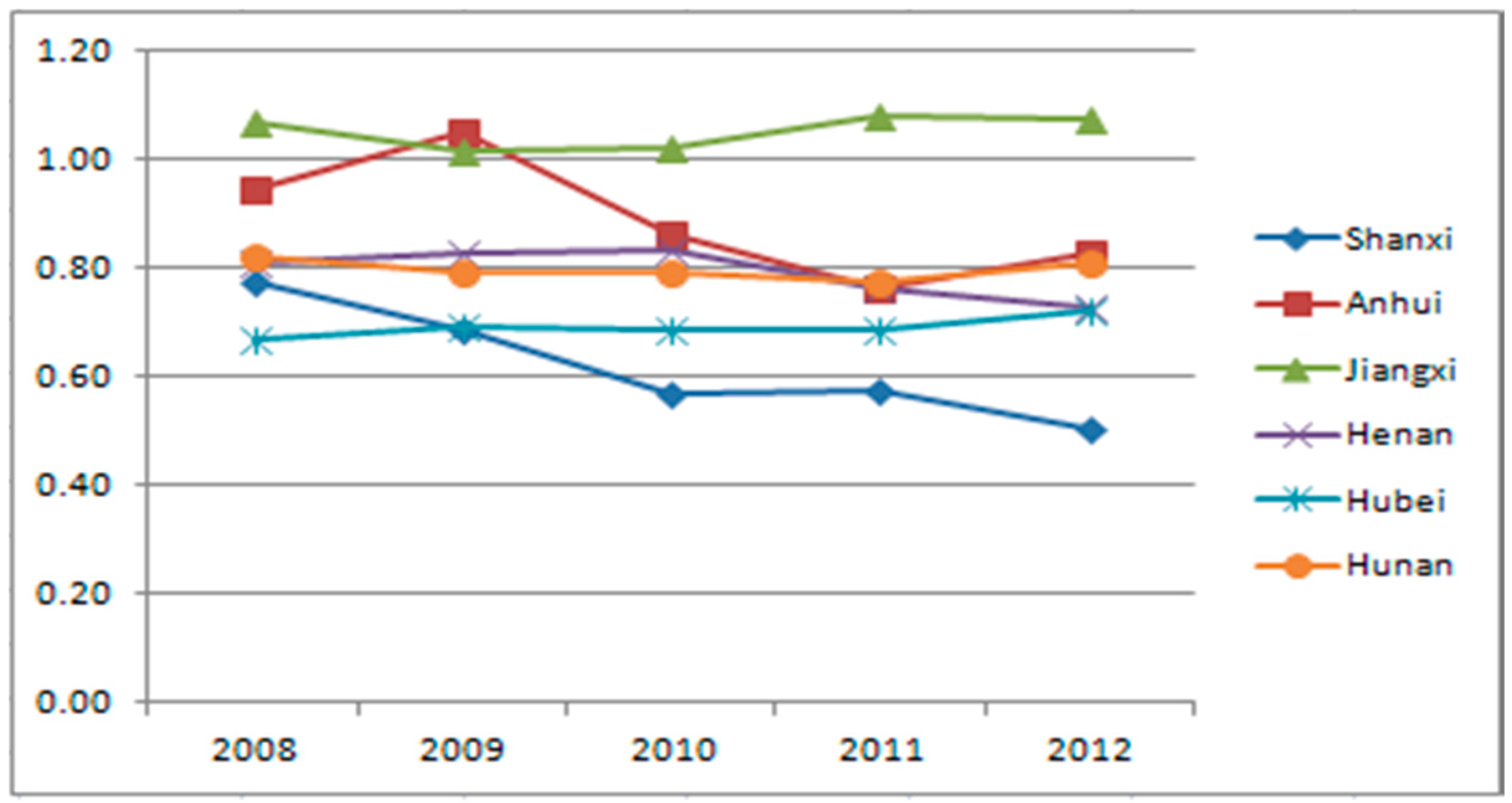
5.3. Western Areas
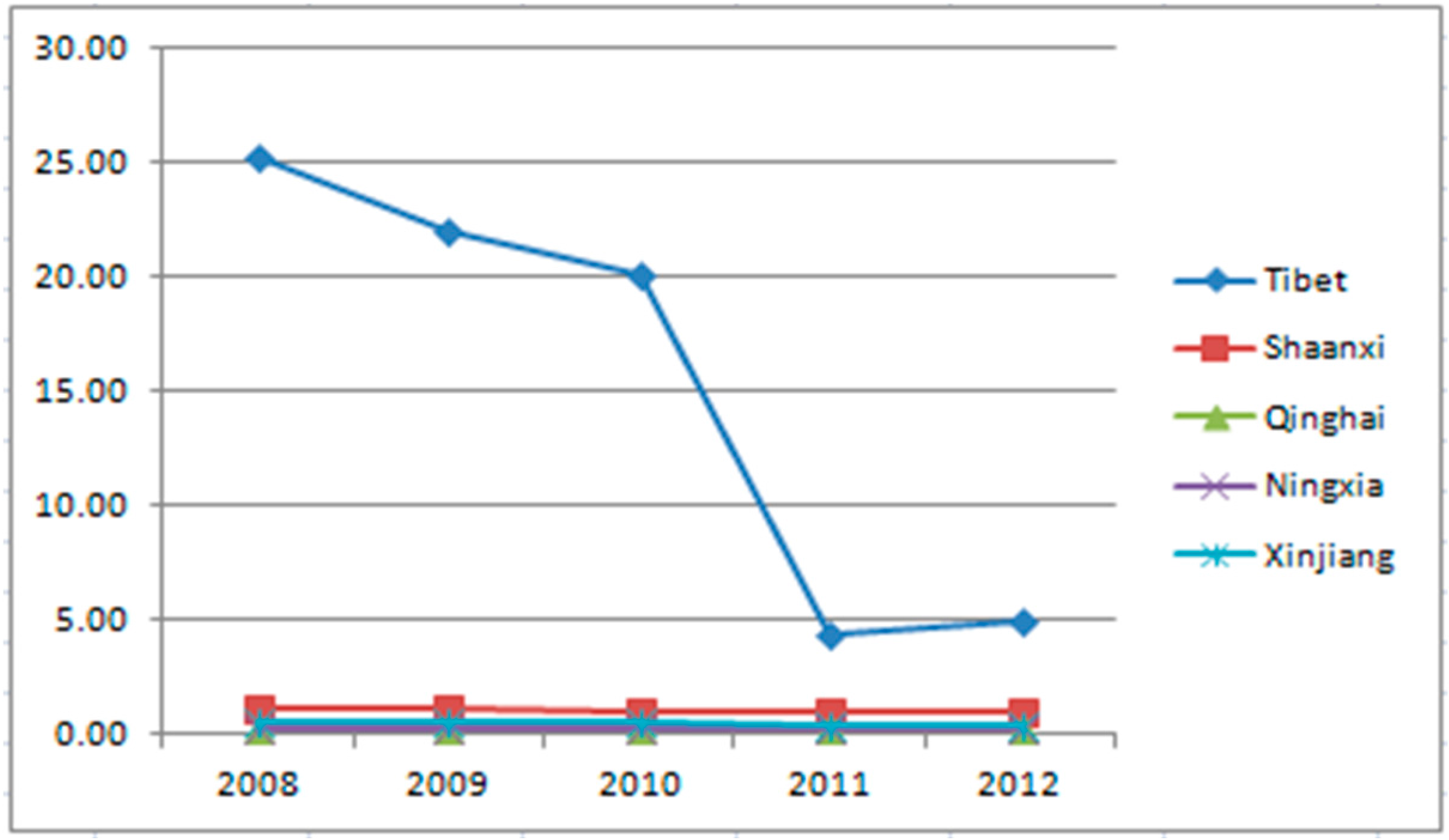
6. Conclusions
Acknowledgment
Author Contributions
Conflicts of Interest
References
- Burnett, J. City buildings—Eco-labels and shades of green! Landsc. Urban Plan. 2007, 83, 29–38. [Google Scholar] [CrossRef]
- Marchand, G.; Michel, S.; Sellami, F.; Bertin, F.; Blanchet, F.; Crowch, A. Tsobgou-Ahoupe, R. Un habitat de la fin du Mésolithique dans le Centre-Ouest de la France: L’Essart à Poitiers (Vienne). L'Anthropologie 2007, 111, 10–38. [Google Scholar] [CrossRef]
- De Oliveira, J.A.P.; Doll, C.N.H.; Balaban, O.; Jiang, P.; Dreyfus, M.; Suwa, A.; Dirgahayani, P. Green economy and governance in cities: assessing good governance in key urban economic processes. J. Clean. Prod. 2013, 58, 138–152. [Google Scholar] [CrossRef]
- Ishwaran, N. Science in intergovernmental environmental relations: 40 years of UNESCO’s Man and the Biosphere (MAB) Programme and its future. Environ. Dev. 2012, 1, 91–101. [Google Scholar] [CrossRef]
- Grossman, G.M.; Krueger, A.B. The inverted-U: What does it mean? Environ. Dev. Econ. 2008, 1, 119–122. [Google Scholar]
- UNEP. Green Economy: Driving a Green Economy Through Public Finance and Fiscal Policy Reform Working Paper. Available online: http://www.unep.org/greeneconomy/ (accessed on 30 March 2015).
- OECD. Green Growth in Cities. Available online: http://www.oecd.org/regional/green-growth-in-cities.htm (accessed on 30 March 2015).
- Wolch, J.R.; Byrne, J.P. Landscape and Urban Planning Urban green space, public health, and environmental justice : The challenge of making cities “just green enough”. Landsc. Urban Plan. 2014, 125, 25. [Google Scholar]
- Dou, X.; Li, S.; Wang, J. Ecological Strategy of City Sustainable Development. APCBEE Procedia 2013, 5, 429–434. [Google Scholar] [CrossRef]
- Bogdan, A.; Istudor, N.; Gruia, R.; Florea, G. New holistic approach of bioeconomics and ecoeconomics theories, practical bridging from the green economy to blue economy, trough new integrated and innovative paradigm about “bio -eco-geo- economy”. Procedia Econ. Finance 2014, 8, 83–90. [Google Scholar] [CrossRef]
- Musango, J.K.; Brent, A.C.; Bassi, A.M. Technological Forecasting & Social Change Modelling the transition towards a green economy in South Africa. Technol. Forecast. Soc. Change 2014, 87, 257–273. [Google Scholar] [CrossRef]
- Nzeadibe, T.C.; Anyadike, R.N.C. City, Social participation in city governance and urban livelihoods: Constraints to the informal recycling economy in Aba, Nigeria. City Cult. Soc. 2012, 3, 313–325. [Google Scholar] [CrossRef]
- Wu, H.; Shi, Y.; Xia, Q.; Zhu, W. Resources, Conservation and Recycling Effectiveness of the policy of circular economy in China: A DEA-based analysis for the period of 11th five-year-plan. Resour. Conserv. Recy. 2014, 83, 163–175. [Google Scholar] [CrossRef]
- Kennedy, S.; Sgouridis, S. Rigorous classification and carbon accounting principles for low and Zero Carbon Cities. Energy Policy 2011, 39, 5259–5268. [Google Scholar] [CrossRef]
- Lehmann, S. Can rapid urbanisation ever lead to low carbon cities ? The case of Shanghai in comparison to Potsdamer Platz Berlin. Sustain. Cities Soc. 2012, 3, 1–12. [Google Scholar] [CrossRef]
- Zeev, S.; Meidad, K.; Avinoam, M. A multi-spatial scale approach to urban sustainability—An illustration of the domestic and global hinterlands of the city of Beer-Sheva. Land Use Policy 2014, 41, 498–505. [Google Scholar] [CrossRef]
- Qing, Y.; Yang, D. Research on the MSP Evolution Patterns of Two-oriented Society Coordinated Development in Regions of China. Procedia Environ. Sci. 2012, 12, 777–784. [Google Scholar] [CrossRef]
- Javadian, M.; Shamskooshki, H.; Momeni, M. Application of sustainable urban development in environmental suitability analysis of educational land use by using AHP and GIS in Tehran. Procedia Eng. 2011, 21, 72–80. [Google Scholar] [CrossRef]
- Yupu, Z.; Yongbo, S.; Jiangbo, Q. Sustainable development of coal cities in Heilongjiang province based on AHP method. Int. J. Min. Sci. Technol. 2012, 22, 133–137. [Google Scholar] [CrossRef]
- Sami, M.; Javad, M.; Pazhohanniya, M. Environmental Modelling & Software Environmental comprehensive assessment of agricultural systems at the farm level using fuzzy logic: A case study in cane farms in Iran. Environ. Modell. Softw. 2014, 58, 95–108. [Google Scholar] [CrossRef]
- Blancard, S.; Hoarau, J.-F. A new sustainable human development indicator for small island developing states: A reappraisal from data envelopment analysis. Econ. Modell. 2013, 30, 623–635. [Google Scholar] [CrossRef]
- Nitkiewicz, T.; Pachura, P.; Reid, N. An appraisal of regional intellectual capital performance using Data Envelopment Analysis. Appl. Geogr. 2014, 53, 246–257. [Google Scholar] [CrossRef]
- Yin, K.; Wang, R.; An, Q.; Yao, L.; Liang, J. Using eco-efficiency as an indicator for sustainable urban development: A case study of Chinese provincial capital cities. Ecol. Indic. 2014, 36, 665–671. [Google Scholar] [CrossRef]
- Charnes, A.; Cooper, W.W.; Rhodes, E. Measuring the efficiency of decision making units. Eur. J. Oper. Res. 1978, 2, 429–444. [Google Scholar] [CrossRef]
- Avkiran, N.K. Association of DEA super-efficiency estimates with financial ratios: Investigating the case for Chinese banks. Omega 2011, 39, 323–334. [Google Scholar] [CrossRef]
- Noura, A.A.; Lotfi, F.H.; Jahanshahloo, G.R.; Rashidi, S.F. Super-efficiency in DEA by effectiveness of each unit in society. Appl. Math. Lett. 2011, 24, 623–626. [Google Scholar] [CrossRef]
- Chung, Y.; Heshmati, A. Measurement of environmentally sensitive productivity growth in Korean industries. J. Clean. Prod. 2014. [Google Scholar] [CrossRef]
- Arabi, B.; Munisamy, S.; Emrouznejad, A.; Shadman, F. Power industry restructuring and eco-efficiency changes: A new slacks-based model in Malmquist–Luenberger Index measurement. Energy Policy 2014, 68, 132–145. [Google Scholar] [CrossRef]
- Macpherson, A.J.; Principe, P.P.; Mehaffey, M. Using Malmquist Indices to evaluate environmental impacts of alternative land development scenarios. Ecol. Indic. 2013, 34, 296–303. [Google Scholar] [CrossRef]
- Rolf, F.; Grosskopf, S.; Lovell, C.A.K.; Pasurka, C. Multilateral productivity comparisons when some outputs are undesirable: A nonparametric approach. Rev. Econ. Stat. 1989, 37, 71–89. [Google Scholar]
- European Commission. Building Environmental Quality Evaluation for Sustainability through Time Network (BEQUEST). Available online: http://cordis.europa.eu/project/rcn/43677_en.html (accessed on 30 March 2015).
- European Commission. A European Thematic Network on Construction and City Related Sustainability Indicators (CRISP). Available online: http://cordis.europa.eu/project/rcn/43677_en.html (accessed on 30 March 2015).
- European Foundation. Urban Sustainability Indicators; Office for Official Publications of the European Communities: Luxembourg, 1998. [Google Scholar]
- UN-HABITAT. Urban Indicator Guidelines–Monitoring the Habitat Agenda and the Millennium Development Goals; UN-HABITAT: Nairobi, Kenya, 2004. [Google Scholar]
- United Nations. Indicators of Sustainable Development: Guidelines and Methodologies; United Nations: New York, NY, USA, 2007. [Google Scholar]
- World Bank. Global City Indicator Programme Report–Part of a Program to Assist Cities in Developing an Integrated Approach for Measuring City Performance. Available online: http://www.cityindicators.org/ProjectDeliverables.aspx (accessed on 30 March 2015).
- China Statistical Yearbook Editorial Board. China Statistical Yearbook 2009–2013; China Statistics Press: Beijing, China, 2009–2013. [Google Scholar]
- China Environment Yearbook Editorial Board. China Environment Yearbook 2009–2013; China Statistics Press: Beijing, China, 2009–2013. [Google Scholar]
- Lindmark, M. An EKC-pattern in historical perspective: Carbon dioxide emissions, technology, fuel prices and growth in Sweden. Ecol. Econ. 2002, 42, 333–347. [Google Scholar] [CrossRef]
© 2015 by the authors; licensee MDPI, Basel, Switzerland. This article is an open access article distributed under the terms and conditions of the Creative Commons Attribution license (http://creativecommons.org/licenses/by/4.0/).
Share and Cite
Yang, Q.; Wan, X.; Ma, H. Assessing Green Development Efficiency of Municipalities and Provinces in China Integrating Models of Super-Efficiency DEA and Malmquist Index. Sustainability 2015, 7, 4492-4510. https://doi.org/10.3390/su7044492
Yang Q, Wan X, Ma H. Assessing Green Development Efficiency of Municipalities and Provinces in China Integrating Models of Super-Efficiency DEA and Malmquist Index. Sustainability. 2015; 7(4):4492-4510. https://doi.org/10.3390/su7044492
Chicago/Turabian StyleYang, Qing, Xingzi Wan, and Huimin Ma. 2015. "Assessing Green Development Efficiency of Municipalities and Provinces in China Integrating Models of Super-Efficiency DEA and Malmquist Index" Sustainability 7, no. 4: 4492-4510. https://doi.org/10.3390/su7044492
APA StyleYang, Q., Wan, X., & Ma, H. (2015). Assessing Green Development Efficiency of Municipalities and Provinces in China Integrating Models of Super-Efficiency DEA and Malmquist Index. Sustainability, 7(4), 4492-4510. https://doi.org/10.3390/su7044492





